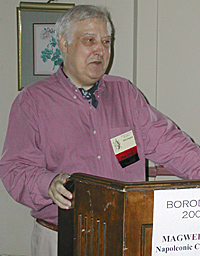 Any in-depth discussion of numbers can cause serious difficulties in lectures. Add in a few formulae and you have the potential to lose audience members. And if you're going to discuss frontages, scale, and formations, you can bet you have to talk about numbers. Fortunately, Bob Coggins handled the entire flow of information, data, and interpretation smoothly as he took the audience on a ride over converting theoretical manuals to battlefield reality and tabletop wargaming.
Any in-depth discussion of numbers can cause serious difficulties in lectures. Add in a few formulae and you have the potential to lose audience members. And if you're going to discuss frontages, scale, and formations, you can bet you have to talk about numbers. Fortunately, Bob Coggins handled the entire flow of information, data, and interpretation smoothly as he took the audience on a ride over converting theoretical manuals to battlefield reality and tabletop wargaming.
One of the problems with Napoleonic formations is that the parade-ground drill that features straight lines and specific gaps degenerates in combat as soldiers tend to huddle together for "protection." The officers and NCOs often had to dress the ranks, not only feeding in troops from rear ranks to replace losses, but also to keep the proper distance between the various formations. Coggins said that frontages in battle could shrink up to 25% as the outer troops bunched inward and some troops lagged behind.
This brought him to a portion about frontages and incuded a variety of formula. In short, if a miniature figure on the tabletop is 3/8" across the front, and given the various French drill book numbers, the ground scale should be 1" = 40 yards if you wish one 15mm miniature figure to equal 79.5 actual men, and 1" = 30 yards for a one 15mm figure = 60 men ratio.
 However, that's only the horizontal calculations. Coggins' depth calculations show that most rules sets mistate depth of such infantry formations by up to 250%--although he notes that cavalry and artillery formations are much closer. Which led him to note that if you intend to position a rule set as "historical," the set must maintain the correct frontages and depth.
However, that's only the horizontal calculations. Coggins' depth calculations show that most rules sets mistate depth of such infantry formations by up to 250%--although he notes that cavalry and artillery formations are much closer. Which led him to note that if you intend to position a rule set as "historical," the set must maintain the correct frontages and depth.
This causes all sorts of problems when you consider maneuvers such as passing lines through other lines, and a far greater sin, losing the effect of cavalry vs. infantry and artillery vs. anyone. In essense, he contended that cavalry has been crammed into too small a space and artillery effectiveness has been overestimated.
In addition, the map scale as laid out on the tabletop exacerbates such problems as the frontage decreases without proportionally decreasing the depth. As a result, most wargames tend to be slugging matches that ignore the flanks. This is often remedied by "artificial" rules that pit "favorite armies" (like the French or British) against "less favorable armies" (like the Spanish or Russians). Thus, firepower tends to be exaggerated for the British, and morale increased for the French while the other armies serve as more cannon fodder than anything else.
More Borodino 2002 Napoleonic Conference
- Welcome, Introduction, and the Hotel Chamberlain
Borodino Ballroom
MagWeb.com Napoleonic Speakers Conference
Friday Lecture: Bob Coggins: Napoleonic Unit Frontages and True Linear Scale
Friday Lecture: Frank Chadwick: The Russian Army at Borodino
Friday Lecture: Jean Lochet: Preparation of French Cavalry for Campaign of 1812
Friday Tour: Fort Monroe Casemate Museum
Friday Keynote Lecture: Dr. William J. Gregor: Long Shadow of Napoleon on American Military Planning
Friday Lecture: Jean Lochet: The Attempt to Rebuild the French Cavalry for 1813
Saturday Lecture: Kevin Zucker: The French Army of 1812
Saturday Lecture: Dr. James H. Birdseye: Glory or Shame? The Role of Morale on the Napleonic Battlefield
Saturday Lecture: Dr. George Nafziger: Prelude to 1812: The 1809 Campaign in Poland
Special Guest: Lt. Col. Andrey Pavlov: Deputy Military Attache from the Russian Embassy
Saturday Lecture: Glenn Drover: Napoleonic Game Design and Production
Saturday Lecture: Jean Lochet: The Peace Conference of Prague: Negotiations with Napoleon During the 1813 Armistice
Video Presentation: Dr. Ben Weider: Borodino Re-enactment 1997
Video Presentation: Austerlitz and Sharpe
Re-enactor Presentations: Russians and French
Borodino: The Wargame
Side Wargames: Survivor, et al.
Awards Banquet
Back to List of Conventions
Back to Travel Master List
Back to MagWeb Master List of Magazines
© Copyright 2002 by Coalition Web, Inc.
This article appears in MagWeb (Magazine Web) on the Internet World Wide Web.
Other military history articles and gaming articles are available at http://www.magweb.com